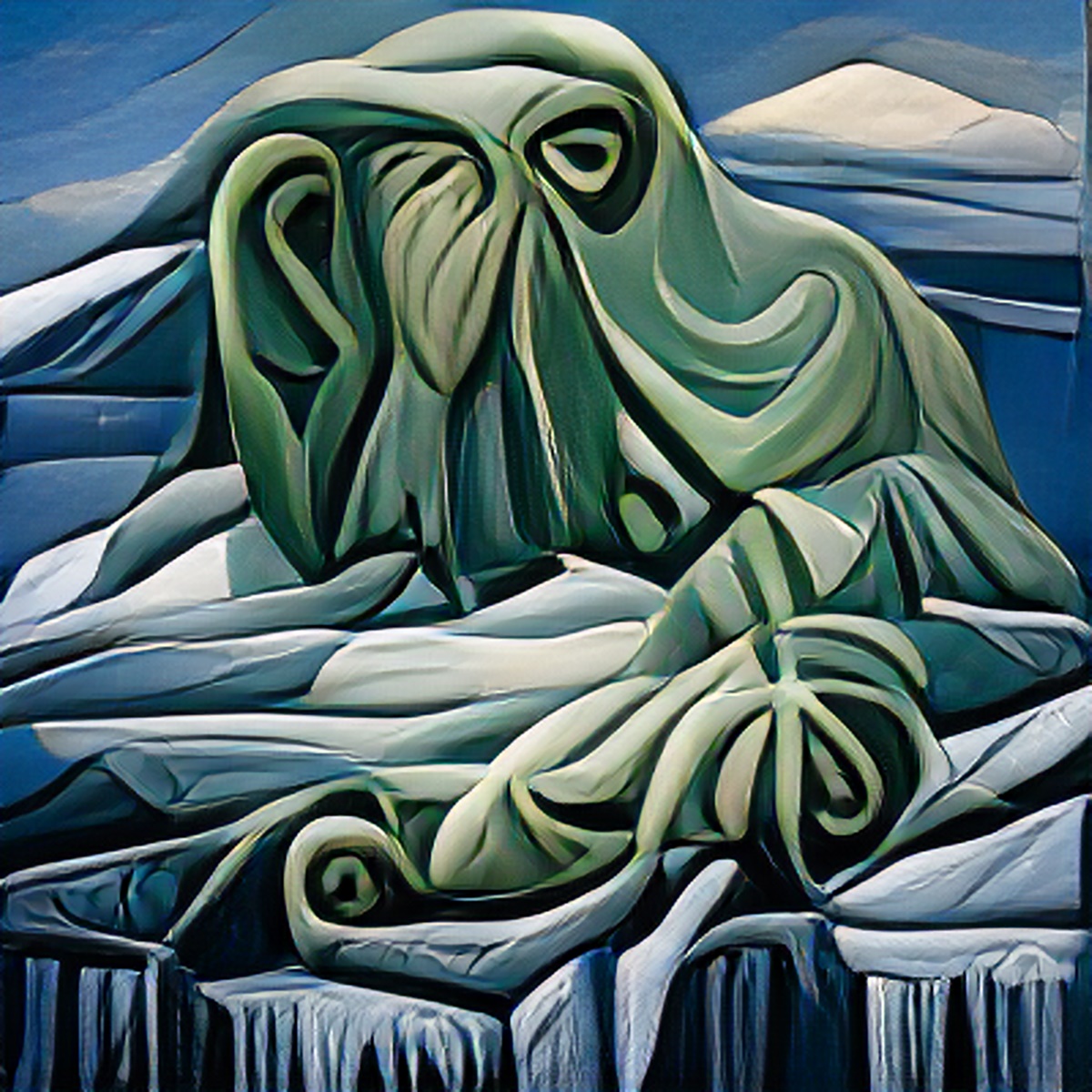News, Trail of Cthulhu
The Forbidden Archive of Canadian Art
Few suspect that the McMichael Gallery of Canadian Art, nestled in formerly bucolic, now exurban, Kleinburg Ontario, houses a forbidden eldritch wing that can be entered only when the stars are right. I myself had no idea until an anonymous informant slipped me these electronic images. Having shared them previously on social media, with only minimal looting and general civic destabilization, I now turn them over to the posterity of the Pelgrane website.
As with my initial presentation of these images, I’m going to start by breaking art historical chronology to present my favorite, and the most emblematic of the lot, Lawren Harris’ “Cthulhu.”

Harris belonged to the famous Group of Seven, and is the best known member of that group outside Canada, due in part to its most famous champion, art collector and comedian Steve Martin. The non-Euclidean nature of that group should be obvious to anyone, as there were more than seven of them.
However, works represented in the Forbidden Wing predate their early 20th century heyday.
Cornelius Krieghoff’s portrait of Brown Jenkin was painted in Montreal between 1847 and 1853. It is a study for a larger work that sadly—or perhaps very luckily indeed—is now lost.

Next we come to Paul Kane and his “Hounds of Tindalos.” Kane sketched during his 1846 trek through the Western territories, fully painting later in his Toronto studio. His glimpse of the Hounds appears to have occurred at The Pas (now Manitoba.)

The greatest legend of Canadian art, Tom Thomson, inspired the Group of Seven. His contribution to the eldritch collection is “Fungi from Yuggoth.” It is surely reductive to suggest that Thomson’s mysterious death in Algonquin Park was somehow connected to the mi-go he encountered there.

The immediacy and menace of “Innsmouth,” by Emily Carr, grants credence to persistent rumors that the true location of that destroyed seaside town was in fact on her beloved British Columbia coast.

We return to the Group of Seven proper with A. J. Casson’s “Shoggoth.” This manifestation of cosmic horror appears to be set in a warped or corrupted version of their hangout, the Arts and Letters Club on Elm Street in Toronto.

“The Haunter of the Dark” by J.E.H. MacDonald solves the problem of showing the terror of absolute darkness by bathing it in a glow perceptible only by inhuman sensory organs.

Next we shudder to Arthur Lismer’s “Byakhee.” Unlike artists who draw merely from descriptions, Lismer, an observant plein air practitioner, captures the creature’s insectoid aspect in addition to the vulture-like elements of its sinister anatomy.

An almost cheerful unease emanates from Frederick Varley’s “Tsathoggua.” The Group of Seven stalwart’s choice to depict the indolent toad god as fur-covered makes sense when you realize that Varley encountered him during his 1938 Arctic expedition.

A. Y. Jackson painted “The Crawling Chaos” after witnessing a peculiar van de Graaff generator demonstration at the Canadian National Exhibition in Toronto.

The withered, mummified god of decay takes on an unexpectedly poignant aspect in Edwin Holgate’s “Quachil Uttaus.”

The Dreamlands iguana god takes a serene bask in Frank Johnston’s “Bokrug Atop His Temple.” Johnston declined to exhibit this piece after fellow Group of Seven members waggishly nicknamed it “The Doom That Came to Sarnia.”

Franklin Carmichael’s “Dunwich Horror” depicts Wilbur Whateley’s brother as a mix of hippo, sauropod, and that most potent symbol of human insignificance against a geologic time scale, the Canadian Shield.

As a contemporary to the Group of Seven who occasionally exhibited with them, Kathleen Munn found herself looking at the Canadian art scene from the outside. But unlike them she dared depict “The Colour Out of Space.”
(Fortunately the colour cannot be perceived in JPEG format.)

David Milne responded to the Group by widening his subject matter and muting his color palette. In “Azathoth” the unseeing idiot god takes on a decidedly autumnal aspect.

Alex Colville’s “Terrible Old Man” relocates the supernatural sea captain’s field of menhirs to the realist artist’s familiar Nova Scotia coastline.

Marshalltown, NS gas station owner Larry Ryan claimed that folk artist Maud Lewis gave him a painting to destroy in 1965: “Goat of the Woods With a Thousand Young.” Does that explain this curious Ekatchrome slide of her studio?

Popular painter Ken Danby turned his realist eye away from hockey goalies and carousel horses to the many scales on a “Shantak.” It was an experiment he would never repeat.

Entries in the forbidden trove of Canadian art thin out with the contemporary era, when figurative works go out of style. An exception, filmmaker/visual artist Joyce Wieland’s “Case of Charles Dexter Ward,” shows her penchant for bold colors and vibrant lines.

The contact who gave me these images assures me that no living artists are included. So, despite the telltale solid blue field behind the main figure, “Pickman’s Model” cannot possibly be the work of Charles Pachter.

Trail of Cthulhu is an award-winning 1930s horror roleplaying game by Kenneth Hite, produced under license from Chaosium. Whether you’re playing in two-fisted Pulp mode or sanity-shredding Purist mode, its GUMSHOE system enables taut, thrilling investigative adventures where the challenge is in interpreting clues, not finding them. Purchase Trail of Cthulhu, and its many supplements and adventures, in print and PDF at the Pelgrane Shop.


